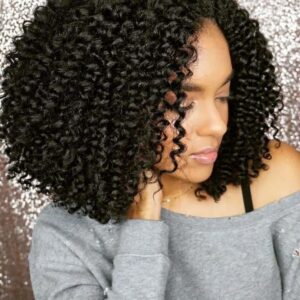Introduction
Low porosity hair is a unique hair type that often requires special care to keep it healthy and manageable. Unlike high porosity or normal hair, low porosity hair has a cuticle layer that is tightly sealed, making it resistant to absorbing moisture and hair care products. If you’ve ever struggled with your hair not absorbing conditioner, or you’ve noticed your products just sitting on your hair, chances are you have low porosity hair.
In this guide, we’ll explore what low porosity hair is, its characteristics, how to care for it, and effective solutions for maintaining healthy, shiny locks. Whether you’re new to hair care or have been struggling with this hair type for years, this post is your one-stop shop for understanding low porosity hair and learning how to treat it with care.
What Is Low Porosity Hair?

Source – https://in.pinterest.com/pin/353251164543902059/
Hair porosity refers to the ability of your hair to absorb and retain moisture. It is determined by the condition of the hair’s cuticle layer, the outermost layer of each strand. The porosity of your hair can fall into three categories: low porosity, medium porosity, and high porosity. These categories determine how your hair interacts with water, oils, and products.
Low porosity hair, in particular, has a cuticle layer that is tightly closed, making it difficult for moisture and hair care products to penetrate the hair shaft. This results in slower absorption of products, leading to a dry or stiff feel unless the products are formulated to work with low porosity hair. Additionally, low porosity hair tends to repel moisture from water-based products and struggles with retaining moisture over time.
How to Identify Low Porosity Hair

Source – https://in.pinterest.com/pin/295759900543223446/
Identifying whether you have low porosity hair can be tricky at first, but with a few simple tests, you can figure it out. Here are a few ways to determine if your hair is low porosity:
- The Float Test:
This simple test involves placing a clean strand of hair in a bowl of water. If the strand floats at the top and doesn’t sink quickly, your hair is likely low porosity. Since the cuticle is tightly closed, it doesn’t allow moisture to penetrate quickly, causing the hair to float.
- Absorption Test:
Apply a few drops of water to a small section of your hair. If the water beads up and doesn’t absorb into the hair shaft within a few seconds, your hair is low porosity. Conversely, high porosity hair will absorb the water quickly.
- Feel Your Hair:
Low porosity hair can feel waxy or greasy at times because products tend to sit on top of the hair rather than being absorbed. It may feel dry or brittle despite regular moisturizing attempts.
Characteristics of Low Porosity Hair

Source – https://www.pinterest.com/pin/787144841159445043/
Low porosity hair has several key traits that distinguish it from other types. Understanding these characteristics can help you provide better care for your hair. Here are a few things you might notice if you have low porosity hair:
- Resistant to Moisture:
As mentioned earlier, low porosity hair is resistant to moisture because the cuticle layers are tightly closed. It takes longer for water and products to penetrate the hair, and they tend to sit on top of the strands rather than being absorbed.
- Product Build-Up:
Due to its inability to absorb products quickly, low porosity hair can easily build up residue from conditioners, styling gels, and other products. This can make the hair look dull, weighed down, or greasy.
- Slow Drying Time:
Low porosity hair tends to dry slowly, especially after washing. This happens because the hair has a harder time releasing moisture, meaning it retains it longer than high porosity hair.
- Shiny Appearance:
Although it can be hard to get moisture into low porosity hair, once it is hydrated, it tends to hold onto shine for longer. The cuticle layers reflect light, giving it a natural glossy finish when cared for properly.
- Prone to Dryness:
Since low porosity hair doesn’t absorb moisture quickly, it may often feel dry and brittle, even with regular use of moisturizing products. This dryness can also cause the hair to break more easily.
How to Care for Low Porosity Hair

Source – https://www.pinterest.com/pin/787144841152478918/
Taking care of low porosity hair requires a strategic approach to ensure that it gets the moisture and nourishment it needs. Here’s how you can keep your low porosity hair healthy and hydrated:
- Use Lightweight Products:
Heavy oils and creams tend to sit on the surface of low porosity hair and can lead to product build-up. Instead, opt for lightweight products that are specifically designed for low porosity hair. These products typically feature ingredients that can penetrate the hair shaft without weighing it down. Look for water-based leave-ins or serums that hydrate without the heaviness of oils.
- Heat for Deep Conditioning:
Applying heat during conditioning is one of the best ways to open up the cuticle layers and allow moisture to penetrate your hair. Using a heated cap, warm towel, or even a blow dryer to create a warm environment while deep conditioning can help your hair absorb the product more effectively.
- Shampoo Less Often:
Since low porosity hair tends to retain moisture longer, frequent washing can strip your hair of its natural oils. Wash your hair less frequently, and try to focus on keeping your scalp clean and free from build-up.
- Clarify Regularly:
Build-up can be a common issue for those with low porosity hair, so it’s important to clarify your hair regularly. Use a clarifying shampoo once or twice a month to remove product build-up and residue. Be sure to follow up with a deep conditioning treatment to restore moisture afterward.
- Use a Humidifier:
Since low porosity hair struggles with moisture absorption, using a humidifier in your home can help. Humidity in the air adds moisture, which can aid your hair in absorbing more hydration and prevent it from feeling dry and brittle.
- Avoid Protein Overload:
Low porosity hair is typically not in need of protein treatments as frequently as other hair types. Overuse of protein can make the hair feel even drier or more brittle. If you notice that your hair feels hard or stiff after a protein treatment, it may be an indication that you’ve used too much.
- Use Oils Wisely:
While oils can be beneficial for low porosity hair, you should use them sparingly. Opt for lighter oils like argan oil, jojoba oil, or grapeseed oil that can easily glide over the surface of the hair without clogging the cuticle. Be cautious with heavier oils like coconut oil, as they can sit on top of the hair and contribute to build-up.
- Consider Protein-Free Shampoos and Conditioners:
If your hair feels stiff and difficult to manage after using regular shampoos and conditioners, consider switching to products that are free from proteins. Protein-free formulas are generally lighter and more compatible with low porosity hair, helping to maintain moisture without adding unnecessary weight.
Styling Tips for Low Porosity Hair
Styling low porosity hair can sometimes be tricky, but with the right approach, it can be done effectively. Here are a few styling tips to keep your hair looking great:
- Use a Leave-In Conditioner:
A good leave-in conditioner can provide extra moisture throughout the day. Apply it to damp hair and make sure to evenly distribute it. This will help lock in moisture while preventing product build-up.
- Avoid Heavy Styling Products:
Stick with light styling creams and gels, and avoid heavy waxes or pomades, which can build up on the hair. Opt for styling products that are designed for fine or low porosity hair to get the best results.
- Try Protective Hairstyles:
Low porosity hair is more prone to damage, so protective styles like braids, twists, and buns can help protect your hair from environmental factors and reduce manipulation, which can lead to breakage.
- Avoid Over-Combining Heat and Products:
Be cautious when using heat styling tools. Since low porosity hair retains moisture and tends to take longer to dry, using excessive heat can cause dehydration and damage. If you must use heat, always use a heat protectant and avoid excessive heat exposure.
Conclusion
Caring for low porosity hair can be a challenge, but with the right knowledge and care, you can keep your hair healthy, hydrated, and shiny. By understanding its unique characteristics and following a tailored hair care routine, you can achieve beautiful, manageable hair that looks and feels amazing.
Remember, the key to caring for low porosity hair is moisture, but it’s also important to avoid build-up, use lightweight products, and be gentle with your hair to ensure its long-term health. With patience and the right techniques, your low porosity hair can thrive, giving you the luscious, vibrant locks you’ve always wanted.

